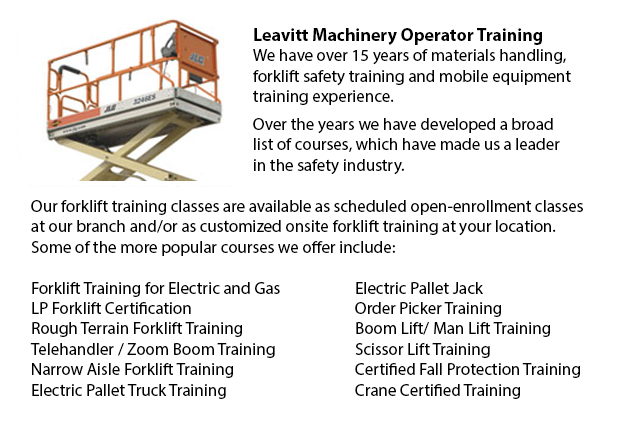
Scissor Lift Certification Vernon - Lots of worksites and tradespeople like welders, masons and iron workers use scissor lift platforms to help them reach elevated work places. The operation of a scissor lift is often secondary to their trade. Hence, it is essential that all operators of these platforms be trained well and certified. Lift manufacturers, regulators and industry all work together to make certain that operators are trained in safely using work platforms.
Scissor lift work platforms are otherwise called manlifts or AWPs. These work equipment are rather easy to use and provide a stable work setting, however they do have risks as they raise people to heights. The following are various important safety concerns common to AWPs:
There is a minimum safe approach distance (likewise known as MSAD) for all platforms in order to protect from accidental power discharge because of proximity to power lines and wires. Voltage can arc across the air and cause injury to personnel on a work platform if MSAD is not observed.
In order to guarantee maximum steadiness, caution must be taken when the work platform is lowered. If you move the load towards the turntable, the boom must be retracted. This will help maintain stability in lowering of the platform.
The regulations about tie offs do not mandate those working on a scissor lift to tie themselves off. Various groups would however, require their employees to tie off in their employer guidelines, job-specific risk assessments or local regulations. The manufacturer-provided anchorage is the only safe anchorage wherein lanyard and harness combinations should be connected.
It is essential to observe and not go over the maximum slope rating. The grade can be measured by laying a board on the slope or by laying a straight edge. A carpenter's level could then be placed on the straight edge and raised until the end is level. By measuring the distance to the ground and dividing the rise by the length of the straight edge, then multiplying by 100, the per cent slope can be determined.
A standard walk-around inspection has to be carried out to determine if the unit is mechanically safe. A site assessment determines if the work place is safe. This is vital specially on changing construction sites due to the risk of obstacles, contact with power lines and unimproved surfaces. A function test must be carried out. If the unit is used correctly and safely and proper shutdown measures are followed, the risks of accidents are greatly lessened.
-
Heavy Equipment Training Vernon
Heavy Equipment Training Vernon - The two most common kinds of heavy equipment training are categorized into the categories of equipment; equipment which is fashioned with tracks and those with rubber tires. The tracked vehicle are heavy duty machine... More -
Aerial Lift, Boom Lift, Man Lift, Scissor Lift Training in Vernon
Lift tables or scissor platform lifts could lift up both people and materials vertically. They are most often utilized in industrial, construction and commercial environments. Usually, the use of a scissor lift is to lift and lower materials from one... More -
Crane Operator Classes Vernon
Crane Operator Classes Vernon - Crane operator training is for operators and supervisors of overhead lifting equipment. The course is suitable for both current and new operators. Course content addresses relevant provincial, state and federal safety... More -
Zoom Boom Training Vernon
Zoom Boom Training Vernon - Zoom Boom Training focuses on correctly training potential operators on variable reach forklifts. The training objectives consist of gaining the knowledge of the machine's physics and to be able to define the tasks of the... More -
Skid Steer Ticket Vernon
Skid Steer Ticket Vernon - The lift arms on the skid-steer loader are situated alongside the driver together with pivots at the back of the driver's shoulders. These features makes the skid-steer loader different than the traditional front loader. Be... More -
Manlift Ticket Vernon
Manlift Ticket Vernon - The Elevated Platforms and Manlifts Certification course helps to provide the needed training on the safe operating procedures, work practice, rules and regulations regarding the daily activities for the operators of this mach... More -
Scissor Lift Ticket Vernon
Scissor Lift Ticket Vernon - The scissor forklift has been a great advantage to many businesses in view of the fact that the effort and manpower to run one of these machines is very minimum. Furthermore, numerous workplace injuries have been prevente... More -
Aerial Lift Safety Training Vernon
Aerial Lift Safety Training Vernon - There are roughly 26 to 30 construction fatalities in North America due to the utilization of aerial lifts. Nearly all of the individuals killed are craftsmen like for example painters, electrical workers, laborer... More

Forklift Training Vernon
TOLL FREE: 1-888-254-6157
Vernon, British Columbia
forklifttrainingvernon.com
Email Us
About Us


